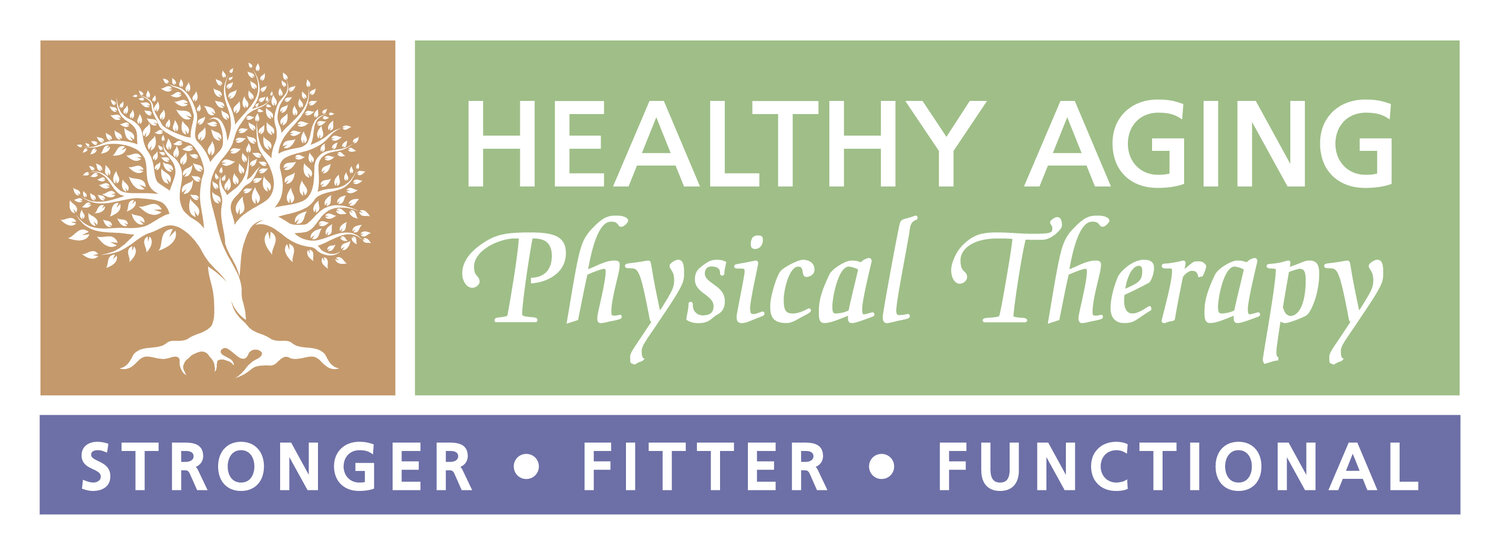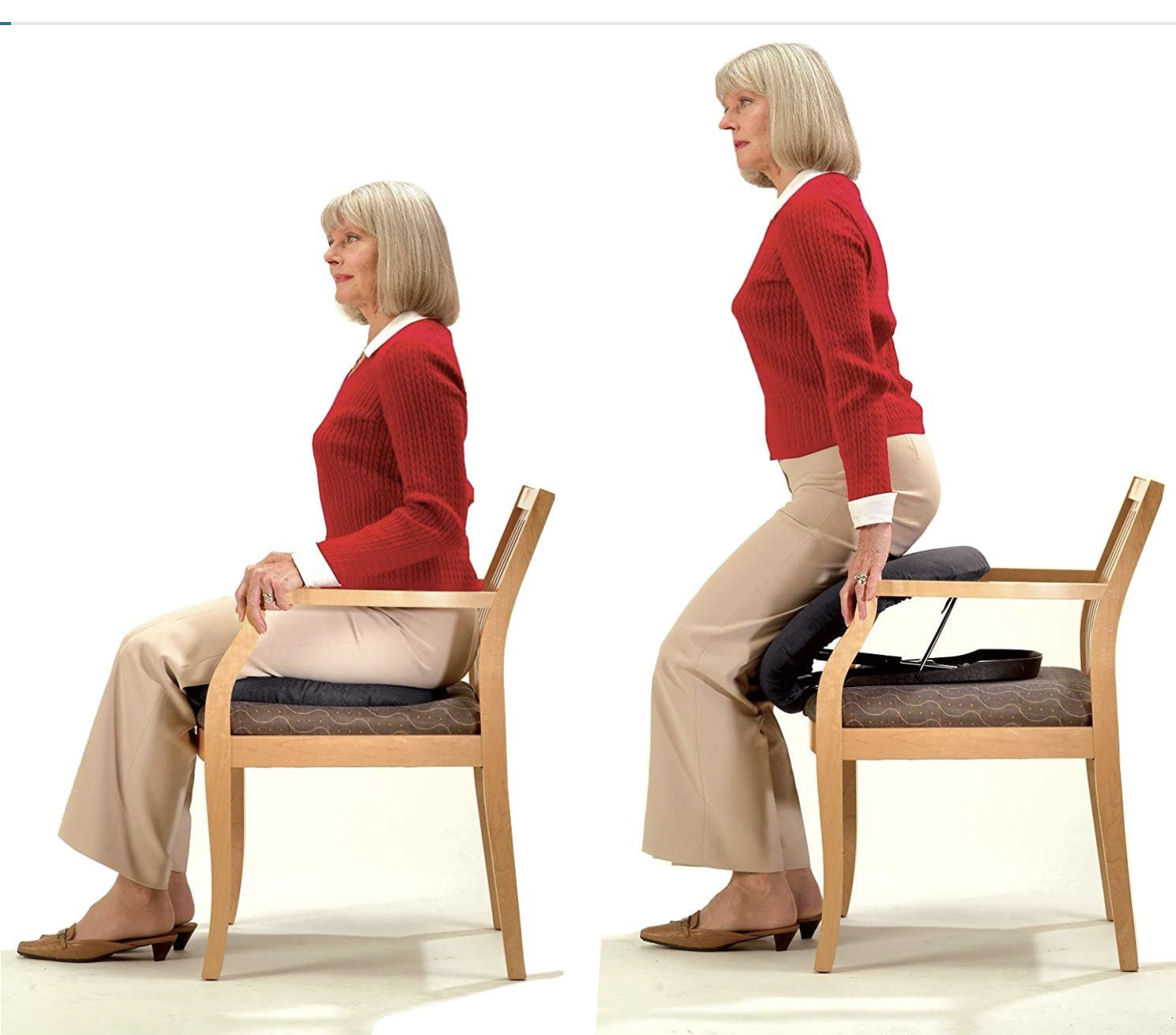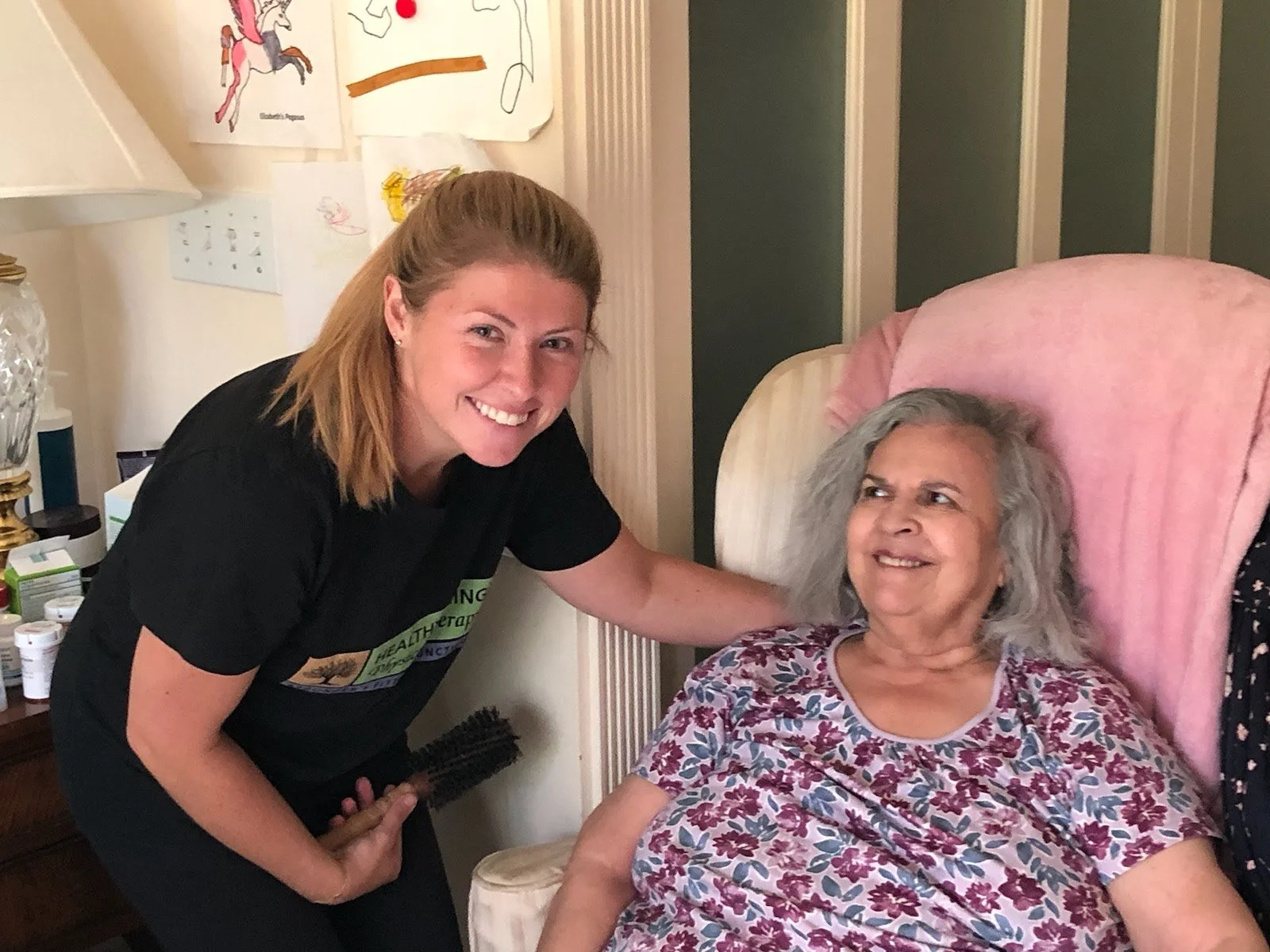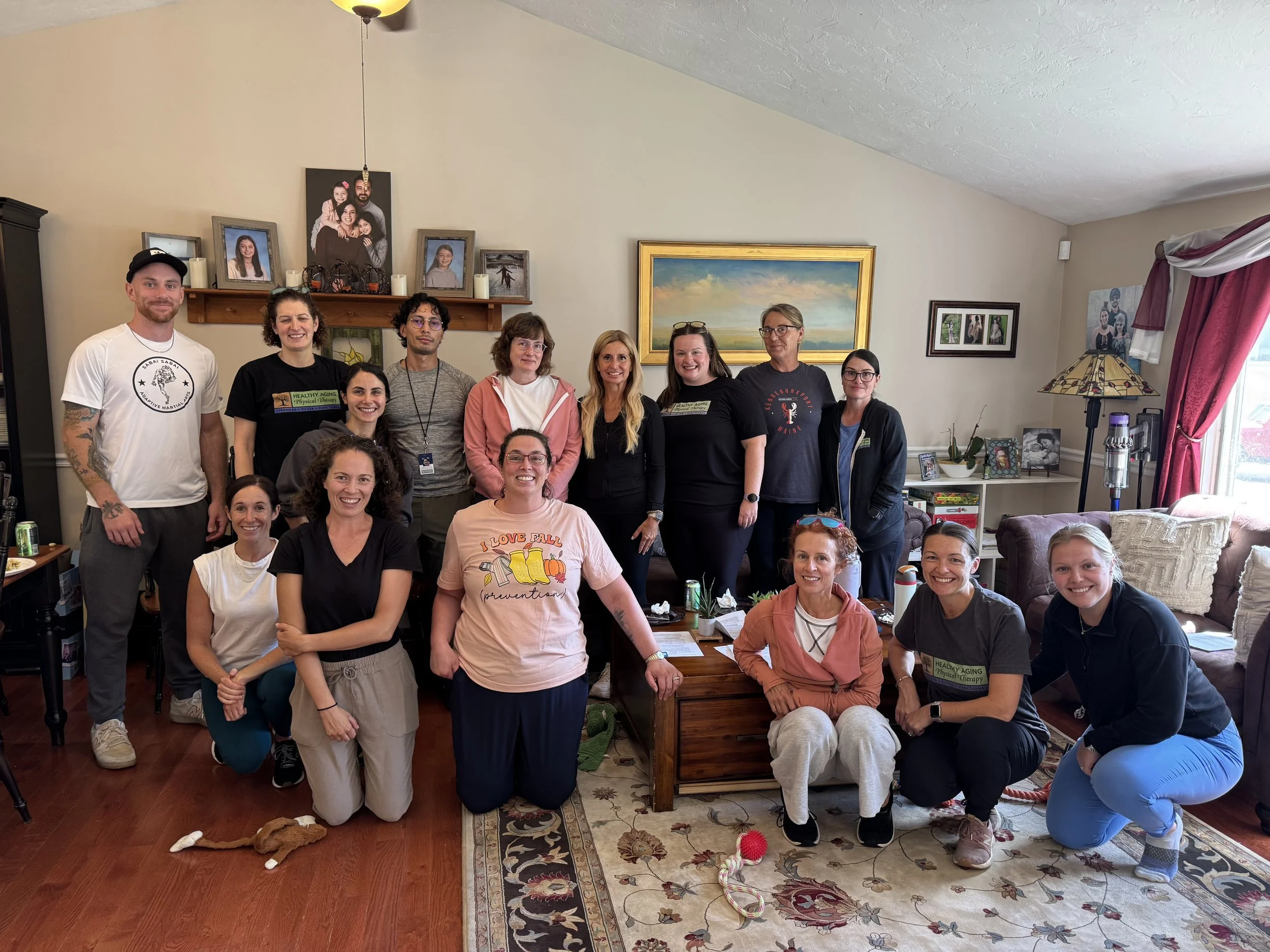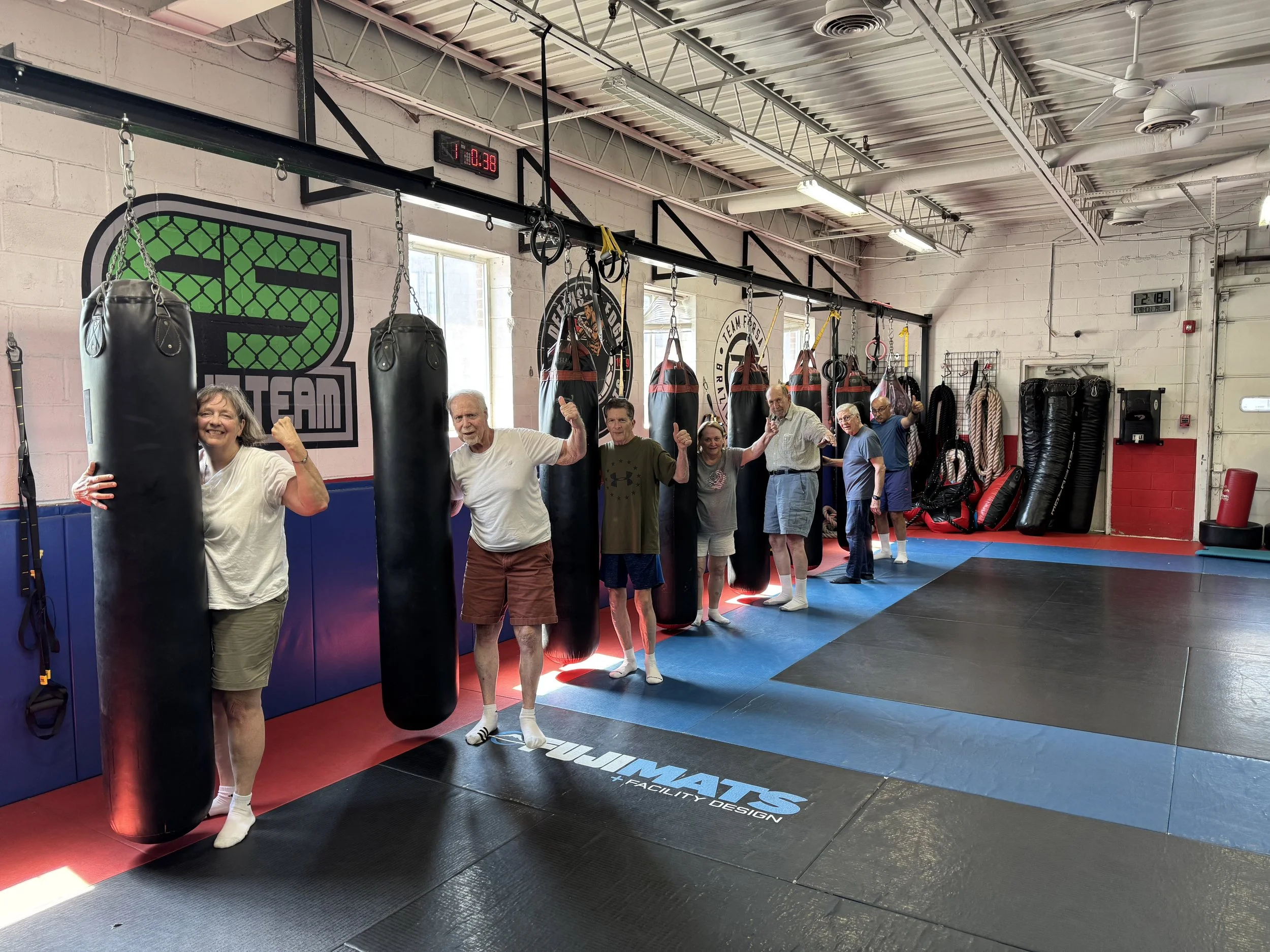Healthy Aging Physical Therapy Monthly Blog
Home for the Holidays: 10 Tips, Tricks, and Helpful Products to Improve Safety at Home - and When You’re Away from Home
Make this holiday season safer and more joyful for the older adults you love. In this post, Dr. Katie Wadland, PT, DPT, Board-Certified Geriatric Clinical Specialist and owner of Healthy Aging Physical Therapy, shares 10 practical tips, tricks, and affordable products to support aging in place—at home or while traveling. Learn how to manage energy, prevent falls, simplify travel, and choose smart gifts that promote safety, comfort, and independence.
By Dr. Katie Wadland, PT, DPT, Board-Certified Geriatric Clinical Specialist
Owner: Healthy Aging Physical Therapy
The holiday season brings joy, family, and togetherness — but also new challenges for older adults. Between traveling, hosting, and adapting to new environments, it’s easy to underestimate just how much energy it all takes. Whether you’re hopping on a plane or staying home in your coziest slippers, a little planning and the right tools can go a long way toward keeping the season safe and comfortable.
Here are ten of my favorite practical, therapist-approved strategies and helpful products to make your holidays easier — without sacrificing the fun.
1. Manage Energy Like It’s Money
One of the biggest challenges of the holidays is fatigue — not just physical, but mental. The social effort of being “on,” chatting with relatives, and maybe even trying to mask any impairments can be draining.
💡 Tip: Think of each day as a dollar — you have $1 to spend. How much will church cost? Dinner with family? A trip to the store for pie ingredients? Spend wisely.
If dinner with your daughter is the highlight, maybe let go of the baking marathon and supervise while the grandkids take over the kitchen.
🎁 Helpful Product: Super Ear Personal Sound Amplifier. Hearing clearly during conversation saves tremendous mental energy.
2. Prepare for Low Surfaces
That comfy couch at your daughter’s house? Not so comfy when you’re stuck in it. While you may confidently get on and off the chairs in your own home, visiting friends, family and restaurants may leave you feeling like Goldilocks trying out difference surfaces to find the ‘just right’ seat for you. Avoid getting stuck with the tips below:
💡 Tip: Start “training” now. Practice sit-to-stands from different surfaces, even try sitting on a pillow to simulate a lower seat.
🎁 Helpful Product: Carex Up Easy Seat Assist — portable, hydraulic seat lift that helps you rise with less strain.
3. Conquer Community Stairs
Even if your home has no stairs, public places or loved one’s homes might. Don’t let a ‘3 STE’ (three stair entry in PT short hand!) stop you from enjoying the festivities.
💡 Tip: Practice toe taps and step-ups at home to build balance and confidence.
🎁 Helpful Product: Try a Stair Cane, which is a lightweight and portable “travel railing” for those steps without rails anywhere or the Stair Assist which lets you create a '“half step” to bridge the gap between the floor and a high step up anywhere you need one.
4. Sleep Smart in New Spaces
Guest beds are often softer, lower, or lack support for getting up. Further, the trip to the bathroom is unfamiliar, and likely dark and dangerous. Solution? BYO-Nightlight and a couple of helpful hints for chair placement:
💡 Tip: Place a sturdy chair or walker next to the bed, and use portable nightlights to light your path to the bathroom.
🎁 Helpful Product: Battery-Powered Motion Nightlights — compact, battery-powered and great for travel.
5. Fly Easier
Air travel can be exhausting long before you board. Fortunately, TSA has excellent support services available not only to reduce strain, but to speed you through long lines and reduce energy cost of travel.
💡 Tip: Call ahead to schedule TSA Cares Assistance for any air travel you have coming up — they’ll escort you by wheelchair through security and to your gate, often bypassing long lines.
🎁 Helpful Product: Drive Medical Nitro Dual Function Rollator/Transport Chair — walk when you can, ride when you need to, this dual-function walker/transport chair is one of my favorites to recommend to my patients.
6. Drive Safely AND Comfortably
While driving cross country may have been doable in your youth, as we age, even short road trips can become more challenging and may require advanced planning.
💡 Tip: Plan for frequent stops, avoid driving tired or at night, and consider public transit or rideshares for longer trips.
🎁 Helpful Product: A portable Car Cane + Car Handle and a Lumbar Support pillow can make getting in and out a breeze, and long drives more comfortable.
7. Stay Connected from Home
If you’re celebrating quietly at home, you can still fill your space with connection and joy.
Smart speakers like the Echo Dot can:
Play your favorite holiday music (“Alexa, play Christmas music!”)
Set medication reminders
Control lights or thermostats
Call for help in an emergency
Get even fancier with an Alexa Show which has all the fun features of a Dot with the addition of a 15” screen so you can see your reminders, follow along with recipes, watch the local news and even see your calendar for the day.
8. Give the Gift of Comfort
Nothing says “I love you - and want you to be safe” like warm, slip-proof slippers and house shoes. Fan favorites in my house AND with my patients include the classic LL Bean Moccasin and the Hey Dude Shoes — both easy to slip on, stable, and cozy.
9. Give the Gift of Health
Aging well takes time, effort and often, support. The good news is that there are great devices and services available to help your loved one stay healthy and active at home. Consider purchasing a portable elliptical like the Cubii or setting them up with a ten pack of training sessions with us through our Wellness365 program. We can bring personal training right to your home, with specialists who understand the needs of older adults.
10. Give the Gift of Safety
Technology is amazing and wearable devices can bring convince, accessibility and peace of mind. Devices like the Apple Watch can now detect falls and call emergency services — a simple, life-saving feature for any older adult.
Final Thought
The holidays aren’t about doing everything — they’re about doing what matters most. Whether that means a little extra planning for your trip to the kids or asking for help at the airport, small choices can keep you safe, confident, and able to enjoy what really counts: time with the people you love.
From all of us at Healthy Aging Physical Therapy, we wish you a safe, warm, and joyful holiday season.
Cutting Through the Chaos: Creating Effective Frameworks for Complex Patients
Many older adults don’t fit neatly into a single diagnosis—and neither does their care. In Cutting Through the Chaos: Creating Effective Frameworks for Working with Complex Patients, Dr. Katie Wadland, PT, DPT, Board-Certified Geriatric Clinical Specialist, shares how Healthy Aging Physical Therapy helps clinicians and families navigate the challenges of treating medically complex patients. Learn how to identify priorities, layer support, and build collaborative care plans that promote safety, independence, and resilience for older adults with multiple conditions.
Written by: Dr. Katie Wadland, PT, DPT, Board-Certified Geriatric Clinical Specialist Owner: Healthy Aging Physical Therapy
If you’ve ever worked with, or been, a patient who seems to have more going on that meets the eye, you know how challenging it can be. Fortunately, these are also often the most rewarding patients - and, most importantly, the ones who need us most.
At Healthy Aging Physical Therapy, our team specializes in exactly that: caring for complex patients—people with multiple diagnoses, long medical histories, and functional challenges who often feel like no one knows where to start. They’re the ones who have seen five other therapists, have a dozen specialists, and still feel stuck.
Why Our Patients Are So Complex
When you’re in physical or occupational therapy school, you learn about impairments in isolation.
A hip fracture? You study how to rebuild strength and balance.
A cardiac patient? You learn to monitor vitals and improve endurance.
A neurological condition? You focus on motor control, coordination, and safety.
But real-world patients with geriatric, neurologic, and complex medical needs don’t fit in tidy boxes. The people we serve are living with multiple comorbidities, often taking many medications, and facing social and emotional challenges that go far beyond their diagnosis list.
For example, many of our patients with Parkinson’s disease also experience osteoarthritis, chronic pain, memory loss, anxiety, and depression - and often have a partner who is also aging and managing their own medical issues to boot. Similarly, a patient referred for “hip fracture” is rarely just an orthopedic case. The fracture may have resulted from a fall, which stemmed from a combination of weakness, balance impairments, cardiac symptoms, and home safety challenges. Many live alone, with limited support and a history of sedentary behavior.
It’s no wonder that walking into these homes for an evaluation can feel overwhelming, even for seasoned clinicians.
Many of these individuals have already been discharged from other settings because progress stalled, the situation was too complicated, or insurance coverage ran out. Over time, we’ve become the go-to practice for these patients—the ones other providers refer when they aren’t sure what else to do. In many cases, we become the last stop—the “hail Mary” for patients who are exhausted from circling through the healthcare system.
So, how do we help?
Our Framework for Treating Complex Patients
Through experience and teamwork, we’ve developed a simple, realistic framework that helps our clinicians navigate these challenging situations - one that keeps both patient and therapist grounded, hopeful, and effective.
Whether you’re a therapist reading this, a patient with a complex background, or a caregiver trying to support a loved one, I hope these strategies help you cut through the chaos and find a starting point that leads to progress.
1. Focus on What Matters Most and Not Everything at Once
When faced with a dozen problems, it’s natural to want to fix them all. But that’s a recipe for overwhelm, and, inevitably, an ineffective therapeutic approach.
Instead, we teach our therapists to start by asking:
“What are the top one or two things we can help with right now that will most improve this person’s quality of life, safety, and independence?”
Sometimes that means addressing strength, balance, or mobility. Other times, it’s about helping the patient move again after weeks (or months) of fear and inactivity. Sedentary behavior, whether from pain, fear, or fatigue, triggers a cascade of physical and emotional decline and often, interrupting this cycle can be an important first step. Even small steps toward safe, confident movement can change everything. Sometimes, a compensatory approach is the right starting point: helping a patient obtain the proper wheelchair, walker, or other durable medical equipment to restore access to their home and community.
Time after time, we’ve learned that small wins matter. They build trust, confidence, and momentum - all critical ingredients for rapport and long-term success.
2. Layer in Support
We remind our team (and ourselves) that we can’t fix everything - and that’s okay. Somethings aren’t ‘fixable’ and other things are outside of our scope and capabilities.
Our role is to make a meaningful difference where we can, while also building a web of support around the patient to provide support for ‘the other things’. That often means:
Connecting patients with mental health providers when mood disorders or anxiety is a barrier
Coordinating with care team physicians and pharmacists to address medication-related issues
Referring our patients to trusted home health aides, elder services, or aging life-care specialists
Providing resources for community programs, support groups, and case managers
It’s not about doing it all ourselves - it’s about building the right team around each patient, one layer at a time.
3. Collaboration Is Key
When you work with a Healthy Aging therapist, you may only see one person walk through your door—but behind that therapist is an entire network of expertise.
Our team includes specialists in neurology, orthopedics, geriatrics, vestibular therapy, and cardiopulmonary rehab. We collaborate behind the scenes through discussion boards, case consults, and joint visits - bringing fresh ideas, new eyes and diverse perspectives to every complex case. Sometimes that collaboration means I’ll step in for a Complex Case Visit, working alongside the treating therapist to strategize solutions. Other times, the team shares insights online, helping each other troubleshoot mobility challenges, medication effects, or behavioral barriers.
That culture of teamwork is one of our greatest strengths—and one of the biggest reasons I feel our patients make progress where others have stalled.
4. Think Long-Term
Complex patients rarely fit neatly into a six-week plan of care. Their needs evolve, new issues arise, and maintaining stability often becomes the goal as much as improvement.
That’s why we emphasize continuity - treating each patient as someone we’ll likely know for years. When a patient is ready to discharge, we make sure:
A comprehensive post-discharge home program is in place
The patient has been connected with the appropriate community and medical supports
We have established a clear plan for future follow-up
For many, we transition them into a Maintenance Plan of Care under Medicare Part B, or into our Wellness program, Wellness365, where they continue to receive guided exercise and ongoing support to prevent decline.
Because our ultimate goal isn’t just short term rehab - it’s recovery and resilience.
What This Means for Patients and Families
If you’re a patient, caregiver, or family member feeling frustrated that “no one knows how to help,” please know: you’re not alone, and your situation isn’t hopeless.
Working with complex conditions takes time, teamwork, and the right perspective. The most important first step is finding professionals who know how to cut through the chaos - and, most importantly, who see you as a person first, not just a list of diagnoses, which is the heart of what we do at Healthy Aging Physical Therapy.
Why More Seniors Are Choosing At-Home Physical & Occupational Therapy
Learn the top 5 reasons older adults are referred for outpatient physical and occupational therapy at home — including fall risk, Parkinson’s care, post-hospital recovery, and more. Discover how at-home PT and OT from Healthy Aging Physical Therapy can help you stay safe, strong, and independent.
By: Dr. Katie Wadland, PT, DPT, Board-Certified Geriatric Clinical Specialist and
Owner of Healthy Aging Physical Therapy
At Healthy Aging Physical Therapy, we specialize in bringing expert care to your doorstep. Outpatient at-home therapy means you get the same high-quality physical or occupational therapy you'd receive in a clinic — but in the comfort, safety, and convenience of your home.
So, why do patients (and their doctors!) turn to us?
Here are the Top 5 Reasons we get referrals for outpatient at-home PT and OT:
1) Fall Risk & Balance Issues
Let’s start with the biggest one — fall prevention.
Falls are the leading cause of injury and hospitalization in older adults, and 60% of them happen at home.
By treating balance issues where they happen most — in the actual environment you live in — we can make a major impact on your safety. Our therapists assess your home for hazards, recommend simple modifications (like grab bars or lighting changes), and provide targeted balance training to reduce your fall risk and keep you confident and independent.
This is our #1 reason for referral — and for good reason. Learn more about our Balance and Falls Program Here
2) Difficulty Leaving the House
Getting to the clinic isn’t always easy. Many of our patients no longer drive, rely on family or caregivers for rides, or find the process of getting ready, getting out, and getting home exhausting.
With outpatient-at-home therapy, we eliminate the transportation barrier and bring care straight to you.
That means you get to use your energy for your session — not the drive — and caregivers get a break from extra errands and logistics. Plus, we often find better focus, higher participation, and more consistent follow-through when therapy is done at home.
3) Parkinson’s Disease
We specialize in helping individuals with Parkinson’s Disease live fuller, more active lives.
Our therapists and trainers are certified in PWR! Moves, an evidence-based therapy program designed specifically for people with Parkinson’s — and our PD program goes far beyond just therapy.
We offer:
Individualized PT & OT
Group fitness classes tailored for Parkinson’s
Personal training with PD-certified instructors
Complex case management
Home safety evaluations and cognitive support strategies
From diagnosis to long-term maintenance, we’re with you every step of the way.
📘 Learn more about our Parkinson’s Program Here
4) Recent Hospital Stay
Even a short hospital stay can cause serious weakness and deconditioning in older adults. Research shows that just 48 hours in a hospital can lead to muscle loss, reduced balance, and increased fall risk.
Whether you were hospitalized for an illness, injury, or surgery, therapy is often essential to helping you get back on your feet — and back to your prior level of function.
We meet you at home as soon as you're ready, and help build a plan to regain your strength, restore your confidence, and safely resume your daily routines.
5) Back & Joint Pain
As we age, it’s common to experience arthritis, spinal degeneration, and general wear-and-tear that leads to aches, pains, and stiffness.
But here’s the difference: While orthopedic clinics often treat just the pain site, our geriatric specialists take a whole-body, whole-person approach — looking at your posture, strength, mobility, balance, and lifestyle. We help you reduce pain and improve how you move, so you can stay active and avoid future injuries.
Why At-Home Therapy Works
Outpatient-at-home therapy is not home health care — it’s the same outpatient services you’d receive in a clinic, but delivered at home. We’re fully licensed, accept Medicare Part B and most managed Medicare plans, and provide:
1:1 focused sessions
Expert therapists and assistants
Continuity of care with the same provider
A personalized, goal-driven approach
📘 Learn more about Outpatient at Home Physical Therapy or Occupational Therapy here.
Want to Learn More?
📞 Give us a call or talk to your provider about a referral. You can register online for a new evaluation by following the link below:
Ready to Supercharge Your Rehab from Home? Meet Motus Nova!
Discover how Motus Nova’s robotic and AI-powered therapy devices can help improve hand and foot mobility from the comfort of home. Learn how Healthy Aging Physical Therapy patients can access this Medicare-covered tool through in-home demos and personalized therapist support.
By: Dr. Katie Wadland, PT, DPT, Board-Certified Geriatric Clinical Specialist and Owner of Healthy Aging Physical Therapy
At Healthy Aging Physical Therapy, we’re always exploring innovative ways to help our patients stay strong, independent, and thriving — and Motus Nova may be the perfect complement to therapy for those recovering from stroke, injury, or facing challenges with hand or foot mobility.
We recently had a fantastic Lunch & Learn with Alyssa Carmell, Occupational Therapist, who introduced us to this cutting-edge robotic and AI-powered rehabilitation tool. We left feeling inspired, informed, and excited about the possibilities it opens up for our patients.
So we wanted to share it with you — because Motus Nova isn’t just an exciting new rehab tool that can improve fine motor control and ankle function… it’s also covered by Medicare!
What is Motus Nova?
Motus Nova (“Nova” means new) is a robotic rehabilitation system originally designed for hospitals and rehab centers — but now available for use right in your living room!
There are two devices:
Motus Hand – helps improve grip, strength, and fine motor control in your wrist, hand, and fingers
Motus Foot – helps with ankle strength, balance, walking, and foot control
Each device uses advanced robotics and fun, game-like exercises to help retrain your muscles and brain. You don’t need to be tech-savvy, and our team can work directly with Motus Nova to help get everything set up and adjusted just for you.
Who Can Benefit from Motus Nova?
Motus Hand or Motus Foot may be a great option if you’ve experienced:
A stroke, even many years ago
Weakness or stiffness in the hand, arm, foot, or ankle
Difficulty with grip strength, balance, or walking
Challenges with rehab after injury or surgery
High or low muscle tone
Whether you’re still in therapy or it’s been a while since you worked on recovery, Motus Nova gives you a chance to continue improving from home — on your schedule.
Why We’re Excited About It
✔️ More reps, more often – Use it daily at home, increasing intensity without exhausting yourself
✔️ Engaging and fun – Play games while getting stronger!
✔️ Designed for home use – No travel, no need for Wi-Fi, and therapist-supported setup
✔️ Customizable – Works for people with no movement or for those who need to fine-tune strength and control
Alyssa shared how patients using Motus Nova have made real, meaningful gains in their independence — and how adding this tool can jumpstart progress when clinic visits alone aren't enough.
Want to Try It? Here's How
If you're working with one of our therapists and we feel that Motus Nova might be a helpful addition to your care, we can arrange a free in-home demo so you can try it out for yourself.
We’ll guide you through setup, talk about how it fits into your rehab or wellness plan, and help you decide if it’s something you want to continue with. No pressure — just options and support.
We’re so grateful to Alyssa from Motus Nova for sharing her time and expertise — and we’re even more excited to share this resource with all of you.
📞 Want to learn more or set up a demo? Call our office to set up an appointment or ask your therapist at your next visit for more information.
Don’t Fall this Fall! Your Guide to Preventing Falls and Staying Strong
Fall Prevention Tips for Older Adults | Healthy Aging Physical Therapy
Discover evidence-based fall prevention strategies using the CDC STEADI framework, including strength and balance training, vestibular therapy, home safety modifications, and fall preparedness education. Learn how Healthy Aging PT helps older adults reduce fall risk and stay independent through 1:1 therapy, personal training, and group classes like Strong and STEADI and Fit & Fearless.
As the leaves begin to fall, let’s talk about a more serious kind of fall - one that affects 1 in 4 older adults each year. Of those, 1 in 5 results in serious injury, including broken bones and head trauma. Even more concerning: once someone experiences a fall, their risk of falling again doubles.
But here’s the good news - falls are not an inevitable part of aging. There are proven, evidence-based strategies that can help reduce fall risk, improve confidence, and even teach people how to fall more safely when accidents happen. And Healthy Aging Physical Therapy is here to help you or your loved ones put those strategies into action.
CDC STEADI Initiative and Fall Prevention
According to the CDC’s STEADI Initiative (Stopping Elderly Accidents, Deaths and Injuries), the key pillars of fall prevention include:
Screening for fall risk using tools like the Timed Up and Go (TUG) or 4-Stage Balance Test
Strengthening and balance training that’s appropriate for age and ability
Medication review and management
Vision and vestibular assessment
Home safety modifications
Education on what to do in the event of a fall
[Source: CDC STEADI Program – https://www.cdc.gov/steadi/]
At Healthy Aging Physical Therapy, we’ve structured our programs around this proven framework to deliver the most effective strategies for fall prevention. Keep reading to learn how we put each pillar into practice.
Screening for Fall Risk
During our therapy evaluations, our licensed physical and occupational therapists conduct standardized, evidence-based fall risk screens, using tools like:
Timed Up and Go (TUG)
4-Stage Balance Test
5 Times Sit to Stand
Berg Balance Scale
Backwards Walking Speed
Gait speed analysis
These assessments help us identify your current fall risk level, evaluate your balance and mobility, and guide the creation of a personalized plan of care. At Healthy Aging, we believe knowledge is power—so we don’t just give you a score, we help you understand what it means. Using age- and gender-based normative values and clinically validated cut-off scores, we compare your results to your peers and determine what they indicate about your individual fall risk. From there, we build a care plan that addresses specific areas of deficit and set clear, measurable goals. These goals allow us to track progress, ensure what we're doing is effective, and pivot when needed to keep you moving forward safely.
Strengthening and Balance Programs
Strength and balance are woven into nearly everything we do here at Healthy Aging Physical Therapy, because we know just how critical they are to aging well. Every Physical Therapy and Occupational Therapy plan of care we create includes targeted interventions to build strength, improve balance, and reduce fall risk. But we also go above and beyond traditional therapy by offering extended support through our Wellness365 program, where specially trained personal trainers work with older adults to maintain and build strength long after therapy ends. For those who enjoy the energy of group fitness, we offer evidence-based classes like Strong and STEADI, which blends balance training, reactive strategies, and floor recovery skills, and Fit & Fearless, our adaptive martial arts program that teaches safe falling techniques and improves agility and body control. Whether you’re just getting started or continuing your wellness journey, our strength and balance programs provide the foundation for safer, more confident movement.
Medication Review and Management
While we don’t prescribe or manage medications directly, our therapists play an important role in identifying potential medication-related fall risks. During every evaluation, we review your current medication list and screen for drugs that may contribute to dizziness, fatigue, or low blood pressure—such as sedatives, antihypertensives, and certain pain medications. When we identify red flags, we collaborate with your physician, nurse practitioner, or pharmacist to recommend a formal medication review or suggest adjustments that may reduce your risk of falling.
Vision and Vestibular Assessment
Our Vestibular Therapy services are provided by clinicians specially trained to treat conditions such as BPPV, vestibular hypofunction, and motion sensitivity. Addressing these issues can significantly improve stability, reduce dizziness, and restore confidence in movement, particularly during sudden turns, head movements, or nighttime activities when balance is most challenged. In addition to vestibular care, we also consider vision as an important piece of the fall prevention puzzle. While we don’t provide eye exams, we screen for vision impairments during PT and OT sessions and refer to optometry or ophthalmology when needed. We also help patients address visual-vestibular integration challenges and provide guidance on modifying the home environment to better accommodate vision changes. Want to learn more? Check out our Vestibular and Dizziness page here.
Home Safety Assessment and Modification
At Healthy Aging Physical Therapy, home safety is an essential part of every plan of care. Our Physical and Occupational Therapists assess your living environment during therapy visits to identify potential fall hazards and barriers to independence. We evaluate factors such as flooring, lighting, stairways, bathroom access, and furniture layout, and we provide tailored recommendations to improve safety and function. When modifications are needed, we help coordinate referrals to trusted professionals who can install grab bars, ramps, railings, and other accessibility features. For those seeking a more in-depth evaluation, either in conjunction with therapy or on its own, we also offer our Home Assessment & Resource Program (HARP). This program provides a focused, expert evaluation of your home environment with personalized safety recommendations and resource navigation to support aging-in-place confidently and safely.
Fall Preparedness Education
At Healthy Aging Physical Therapy, we also believe fall preparedness is just as important as fall prevention—because even with the best strategies in place, accidents can still happen. That’s why our therapists receive advanced training in fall preparedness education, including safe falling techniques, floor recovery strategies, and how to respond if a fall occurs. We routinely make getting on and off the floor a core part of therapy, recognizing that this essential skill is often overlooked in traditional rehab settings. Whether someone is learning to recover independently after a fall or safely call for help when needed, our goal is to build both skill and confidence. For those who want to go even deeper, our Fit & Fearless program offers a supportive group environment where participants practice safe landing techniques, controlled descents, and reactive balance drills inspired by adaptive martial arts. It's an empowering, innovative approach to fall preparedness that helps older adults feel strong, capable, and ready for whatever life throws their way.

